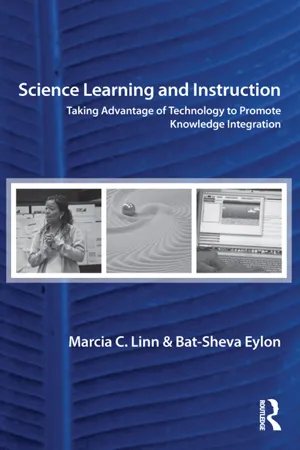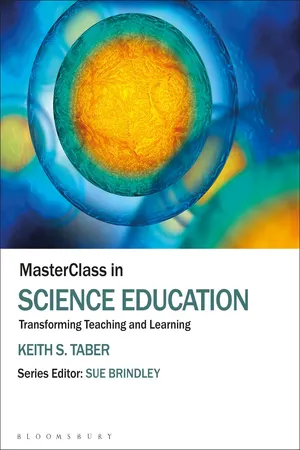Chemistry
Particulate Model
The particulate model is a conceptual framework used to explain the behavior of matter at the particle level. It describes how particles are arranged, move, and interact in different states of matter. This model helps to understand phenomena such as diffusion, phase changes, and the behavior of gases, liquids, and solids.
Written by Perlego with AI-assistance
Related key terms
Related key terms
1 of 4
Related key terms
1 of 3
3 Key excerpts on "Particulate Model"
- eBook - ePub
Science Learning and Instruction
Taking Advantage of Technology to Promote Knowledge Integration
- Marcia C. Linn, Bat-Sheva Eylon(Authors)
- 2011(Publication Date)
- Routledge(Publisher)
4
PARTICULATE STRUCTURE OF MATTER
A Case Study
Introduction
In this chapter we discuss a case study of curriculum reform that revealed some promising patterns for high school physical science. The case study involves helping students understand the structure of matter and was conducted by Eylon and her colleagues in Israel (Ben-Zvi, Eylon, & Silberstein, 1986a, 1988; Linn, Songer, & Eylon, 1996; Margel, Eylon, & Scherz, 2008).Structure of Matter
Materials has always been a central topic in junior high school science studies and usually includes the following topics: the particulate nature of matter; states of matter; changes in the state of matter; atoms and molecules; elements, compounds, and mixtures; the structure of the atom; and the relationship between the structure and properties of materials. Many of the traditional curriculum approaches (Dory et al., 1989; Zilag et al., 1980) are based on declarative definitions of the scientific concepts and on confirmatory experiments. In particular, in many textbooks the ideas about the particulate nature of matter are presented as postulates: that matter consists of particles that are too small to be seen; that particles are in intrinsic motion; that there is empty space between the particles. The structure of matter is one of the most fundamental topics in science. A meaningful understanding of this topic is essential for developing a solid basis for further scientific studies. It is revisited in high school chemistry courses but not all students take these courses so middle school physical science is often the first and last time that students encounter this topic. - eBook - ePub
Foundations for Teaching Chemistry
Chemical Knowledge for Teaching
- Keith S. Taber(Author)
- 2019(Publication Date)
- Routledge(Publisher)
a multitude of repeating units that comprise a limited number of types of molecules, atoms, and/or ions ? That might reflect the teacher’s SK, but is not an idea that learners new to chemistry are likely to be able to readily make good sense of and apply.
Some space has been given over to discussing this rather basic chemistry because:Consolidation and progression in learning about the submicroscopic nature of substances- the notion of a single substance is one of the most fundamental and important concepts in chemistry;
- relating our macroscopic chemical concepts to submicroscopic quanticle models is possibly the most powerful and widely used basis for explanations in chemistry and reflects a key competence we expect students to demonstrate in school chemistry;
- 3. there is no simple principle (such as a pure substance contains one type of atom/molecule/ion) that we can teach students to introduce this idea and which works for the range of substances they will learn about.
This present a challenge to teachers, given that we know that learning tends to be incremental and therefore teaching needs to be broken down into manageable steps. This is an area where students experience learning difficulties. Some fail to distinguish figures showing molecules representing samples of single substances (elements or compounds) and mixtures after they have been taught the basic ideas (Briggs & Holding, 1986).We know that learning is not only incremental, but iterative, so we need to plan teaching so that students are able to build more sophisticated understanding upon more basic ideas and examples. When students are starting from non-canonical alternative conceptions, they will tend to construct new knowledge to be consistent with their existing non-scientific ideas. In the case of a substance which can be considered to be composed of discrete molecules, we have a fairly simple situation – samples of this substance contain only one type of molecule. We can teach this idea as a starting point for understanding substance at the submicroscopic level – as long as we do not suggest all examples can be understood in precisely this way - eBook - ePub
MasterClass in Science Education
Transforming Teaching and Learning
- Keith S. Taber(Author)
- 2018(Publication Date)
- Bloomsbury Academic(Publisher)
Sadly, students commonly misunderstand this affordance of the theory. Where the scientific model explains the types of properties and behaviours that can be directly observed in terms of the very different nature of the quanticles conjectured to comprise materials, students often assume the theory is meant to be applied as substance X does (whatever) because its particles do (whatever). This can become a widely adopted alternative conceptual framework (see Figure 12.1), for example: • Glass is transparent because glass particles are transparent. • Gold is shiny because gold particles are shiny. • Ice is cold because ice particles are cold. • Wax melts easily because wax particles melt easily. • Copper conducts because copper particles conduct. Yet glass particles are not transparent; gold particles are not shiny; ice particles are not cold; wax particles do not melt easily; and copper particles do not conduct. That is not to say that glass particles are opaque or gold particles are dull etc., but rather these sentences make the error of applying macroscopic concepts (shiny, cold etc.) to quanticles which need to be described in rather different terms. To put this alternative conception into context, we might note that when Democritus proposed ‘atoms’, he saw them as hard, solid atomos (‘indivisible’) – a bit like tiny indestructible billiard balls, and not at all like the fuzzy balls of electric fields described above. Moreover, when atoms were (again) proposed at the start of early modern chemistry, acids, which are said to have a ‘sharp’ taste, were considered to be comprised of sharp, spiky particles
Index pages curate the most relevant extracts from our library of academic textbooks. They’ve been created using an in-house natural language model (NLM), each adding context and meaning to key research topics.
Explore more topic indexes
Explore more topic indexes
1 of 6
Explore more topic indexes
1 of 4


